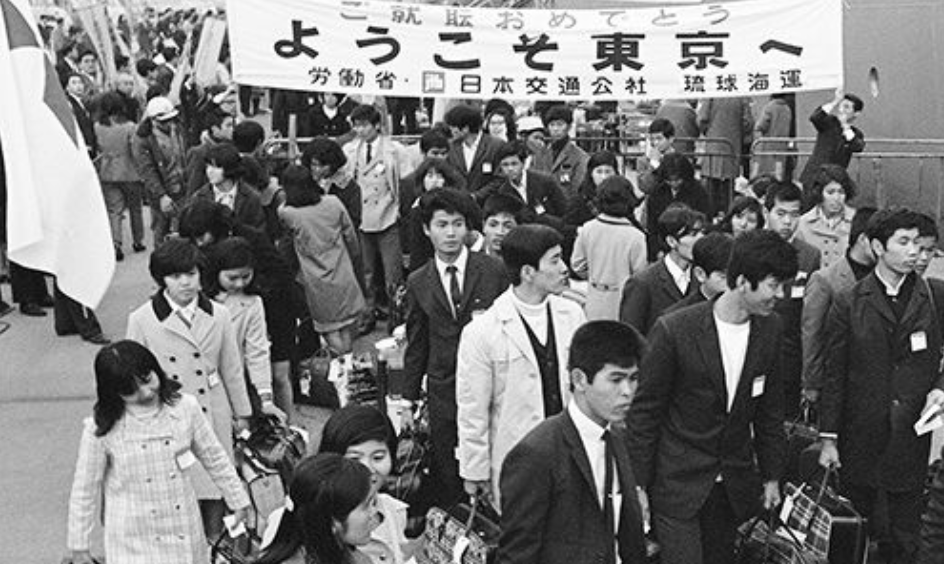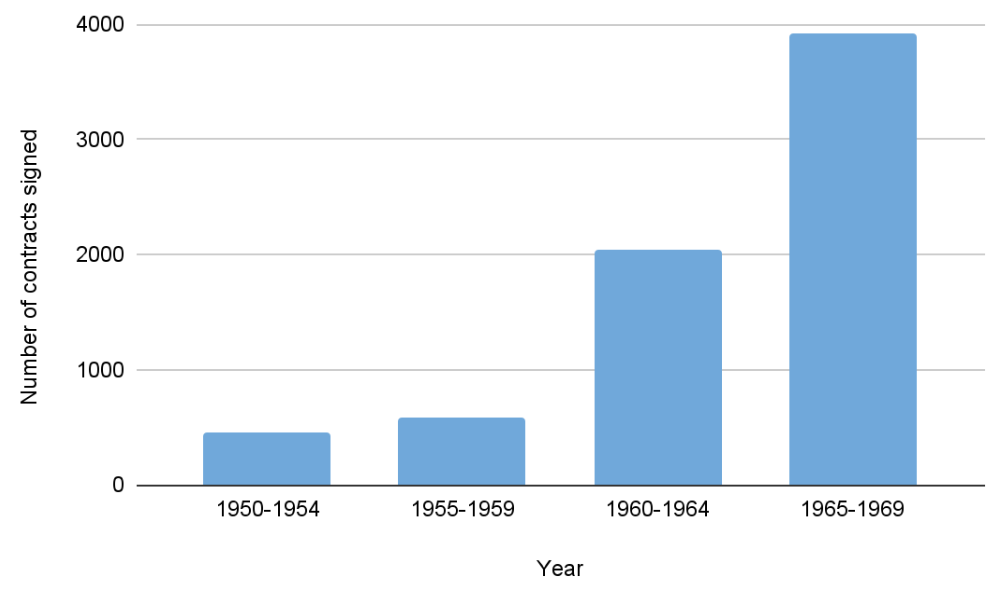
HANNAH SHIOHARA – JANUARY 26TH, 2023
EDITOR: PALLAVI MURTHY
Economist Milton Friedman once said that “The best way to grow rapidly is to have the country bombarded.” Though it is hard to imagine a country prospering after losing everything, the Japanese post-war economy did just that. Japan unconditionally surrendered on August 14th 1945, with World War II costing the country an estimated 2.6 to 3.1 million lives and 56 billion USD. Though Japan was left with almost nothing, their economy recovered at an incredible speed. Known as the Japanese Economic Miracle, Japan experienced rapid and sustained economic growth from 1945 to 1991, the period between post World War II and the end of the Cold War. As depicted in Figure 1, the real growth rate was positive until 1973 and increased for 20 consecutive years. In less than ten years, Japan’s economy was growing at a peak rate last observed in 1939, with the economy growing two times faster than the prewar standard every year past 1955. There are four main factors that allowed for this super rapid growth: technological change, accumulation of capital, increased quantity and quality of labor, and increased international trade. Through strategic planning and cooperation by firms, individuals, and the government, Japan manipulated these factors to become the third-largest economy in the world. Though it has been 77 years since the end of World War II, many elements of Japan’s economic recovery remain relevant to our society and can be applied to countries that have recently emerged from conflict.

Figure 1. Japan’s real economic growth rate between 1950-1973 in 4 year increments.
Factor 1: Technological change
After the war, Japan had lost more than a quarter of its industrial capacity and was only left with over-depreciated capital stock that had no use. This allowed Japan to adopt an abundance of new technologies without having to wait for assets to be fully depreciated, fueling Japan’s voracious appetite to start fresh and innovate. Figure 2 depicts the number of contracts signed to import new technology, mainly in industries such as iron, steel, petrochemicals, electronics, motor manufacturing, and chemical engineering—sectors characterized by extremely high growth rates.

Figure 2. Number of contracts with a life of more than a year and paid in foreign currency that Japan signed to import new technology between 1950 and 1969.
Furthermore, several government policies favoring these technological changes were implemented. First, the government aggressively used expansionary monetary policy to create “cheap money,” such that growing industries had access to low-cost funds. Interest rates were rigid and closely monitored to be kept low, and corporate businesses were over borrowing while banks over loaned. The government also rewarded growing businesses with generous depreciation provisions and tax deductions; large, more rapidly growing corporations had lower tax rates than smaller, slower-growing firms. Personal income taxation was also slowed through partial exemption of interest and dividend incomes from taxation.
Foreign countries greatly influenced and inspired the creation of new technologies, and Japan began importing tremendous amounts of goods as well. For example, machine tools and robots were imported and became widely used in the automobile industry, while imported generators were adapted to improve the efficiency of the electric utility industry. In 1963, the Japan Information Center for Science and Technology wrote 210,000 abstracts of foreign scientific papers to make foreign ideas and knowledge accessible. The Japanese also took the new technologies they imported and improved it themselves, making the technology an estimated 20% more efficient. 9500 large firms reported on spending a third of their R&D expenditure and “modifying and perfecting the imported technique.”
Factor 2: Accumulation of capital
In order to import and implement the new technologies mentioned above, the Japanese concentrated their capital into investing in rapidly growing manufacturing industries. In contrast, people in other countries were investing more in housing or other social overhead capital. This difference came from the Japaneses’ great desire to close the technological gap between Japan and foreign countries and increase their international competitiveness. At the time, the returns of these investments were high because the marginal productivity of capital was so high. In order to balance these large investments and avoid extremely high inflation, there was also a high rate of personal saving. During 1959 and 1970, the ratio of personal savings to disposable income averaged at 18.3% in Japan, while it was only 12% in Germany and 7% in the United States.
Factor 3: Quantity and quality of labor
The increase in quantity and quality of labor also greatly contributed to Japan’s success, with the National Bureau of Economic Research estimating that it accounted for nearly 30% of the postwar Japanese growth. As people returned from war, there was a large increase in labor, allowing for wages to rise less than labor productivity in the 1950s. Even in the 1960s, productivity kept pace with wage increases, giving firms the ability to be efficient and grow. Labor also moved from low-productivity sectors such as agriculture and forestry, to high productivity sectors such as aviation, automobile, and electronics.
A key element to the Japanese Economic Miracle was the keiretsu. Keiretsu were very large business groups that linked banks, trading companies, and industrialists through ownership or stock and long standing exclusive relationships. Their mere size gave them the financial strength and connections they needed to outperform their domestic and foreign rivals, aggressively gaining market share in high-growth sectors with long term potential. The government also worked in favor of the keiretsu, implementing policies that would minimize any competition for the firms. The Ministry of International Trade and Industry allowed “administrative” cartels and collusive activities to take place, with more than 1,500 of them going unprosecuted. For example, mergers amongst the five largest firms in a given industry were approved, supporting anti-competitiveness. At the same time, the workplace culture of keiretsu played a large role in its success, because it improved the quality of labor. The Japanese business environment was extremely competitive, and all companies went to great lengths to keep up with one another. In order to continuously update product designs and implement new production techniques, employees were expected to work extremely long hours and stay loyal to the firm for a lifetime. They were held to high standards with strict rules, such as how low to bow to various superiors, with training for these roles starting at a young age. In fact, several of the world’s most practiced industrial practices such as total quality control, lean production, and cross-functional product teams are said to be first implemented in the keiretsu.
Factor 4: International Trade
Finally, Japan’s exports grew rapidly after the war, boosting the economy. By providing tax deductions for overseas sales expenditures and preferential loans, the government was able to lower the prices of exports, making them relatively cheaper than other countries. The mergers and anticompetitive behavior they encouraged were also mainly in sectors that exported their products. However, the single most important factor in international trade that allowed Japan to stay ahead of its competitors was its ability to change what they were exporting every couple of years. Between 1950 and 1965, Japan went from primarily exporting textiles and sundry goods to machinery, and finally to metals. Due to increased efficiency and corporations’ ability to keep up with changes in the international trading stage, Japan was able to provide goods that were in the most demand, increasing exports and thus real economic growth.
Lessons learned from the Japanese Economic Miracle
Today, most war-stricken countries are developing countries whose economies are primarily based on agriculture. For example, there were 15 countries at war in Sub-Saharan Africa in 2019. Specifically, Ethiopia’s civil war continues to be one of the most devastating conflicts of 2022. Agriculture in Ethiopia accounts for nearly 46% of GDP and 85% of total employment.
Since it is evident that favorable government policies played a crucial role in Japan’s economic recovery, comparable policies should be implemented in today’s post-conflict countries. For example, governments should shift their revenue source away from personal and business income taxes and to natural resource rights. Since these countries are abundant in natural resources and because natural resource extraction tends to decline during war, there will be a large demand for commodity goods in post-war economies. Instead of taxing firms’ operating in the primary sector, the government could tax the sale of the right to extraction, done through an auction that the African Union can oversee in cooperation with the Union African Development Bank and OECD. By making tax cuts in personal and business incomes, citizens and businesses can have some leeway in their post-war recovery. Taxing natural resource rights instead will make it easier for firms in high-growth sectors to make profits, but still ensure revenue for the government.
Furthermore, increased international collaboration will be imperative for the economic growth of post-conflict countries. While increased exports and the sharing of knowledge with foreign countries greatly contributed to Japan’s success, international agreements can help developing economies of today. Since commodities are subject to significant fluctuations in price, some economists have suggested negotiating international “commodity stabilization agreements” to protect vulnerable, but growing sectors. Also known as price band buffer stock programs, governments would purchase a given quantity of goods at a fixed price, and then sell them for a fixed price such that prices are contained within a band. Though these policies are controversial as they cause inefficiency, research shows that price stabilization for coca, coffee, jute, wool, and wheat is greatly beneficial to its exporting countries. They would generate greater export revenue as well as create a positive pure welfare impact. Some of the poorest developing countries located in West Africa, Latin America, and Asia would be greatly supported by these policies.
While the circumstances of a country emerging from war in 1945 is drastically different from today, concentrating on dominating high and long-term growth industries is a key goal that remains relevant and effective for recovering economies. This will require the cooperation of governments and foreign countries through favorable taxation policies and negotiations that give growing but vulnerable firms an advantage. By identifying a country’s comparative advantage and fulfilling that industry’s potential, a country may be able to experience rapid recovery and growth to birth their own “Economic Miracle.”
Featured Image Source: nippon.com
Disclaimer: The views published in this journal are those of the individual authors or speakers and do not necessarily reflect the position or policy of Berkeley Economic Review staff, the Undergraduate Economics Association, the UC Berkeley Economics Department and faculty, or the University of California, Berkeley in general.



